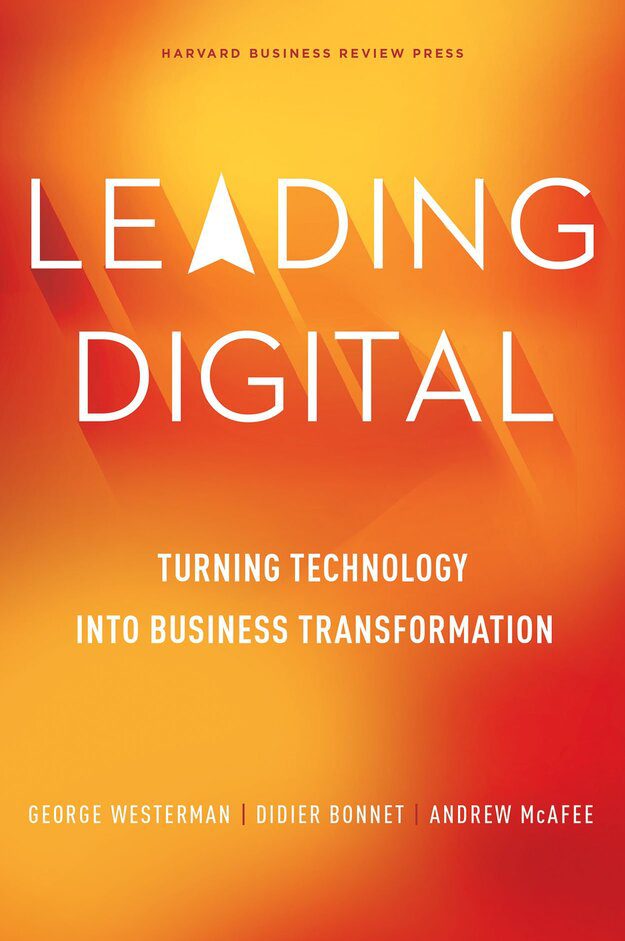Print | Kindle(eBook) | Audiobook
The Core theme of Leading Digital by George Westerman:
Within the next ten years, industries, economies, and probably entire societies will be transformed by a barrage of technologies that until recently have existed only in science fiction, but are now entering and reshaping the business world. Becoming a Digital Master is challenging, but there has never been a better time. The longer you wait, the more difficult it will become
In Leading Digital, authors George Westerman, Didier Bonnet, and Andrew McAfee highlight how large companies in traditional industries—from finance to manufacturing to pharmaceuticals—are using digital to gain strategic advantage. They illuminate the principles and practices that lead to successful digital transformation. Based on a study of more than four hundred global firms, including Asian Paints, Burberry, Caesars Entertainment, Codelco, Lloyds Banking Group, Nike, and Pernod Ricard, the book shows what it takes to become a Digital Master.
Here are my favourite take-aways from reading, Leading Digital by George Westerman, Didier Bonnet, and Andrew McAfee:
Success in digital transformation is as much about what you don’t do as what you do. In the context of so many opportunities to digitize your business, it’s easy to become distracted by the latest shiny object. But when it comes to making real strategic commitments, investing real dollars, and involving real people, only a focused approach to digital transformation delivers real business value.
Digital Masters
Companies that struggle with becoming truly digital fail to develop digital capabilities to work differently and the leadership capabilities required to set a vision and execute on it. The firms that excel at both digital and leadership capabilities are Digital Masters.
Digital Masters, in short, keep making digital technologies work for them even though the technologies themselves keep changing. Digital Masters excel at two essential capabilities. They build digital capabilities by rethinking and improving their business processes, their customer engagements, and their business models. They also build strong leadership capabilities to envision and drive transformation. Each dimension of capability is important on its own. Together, they make you a Digital Master.
Digital Invetability
The elements of the digital world—software, hardware, networks, and data—are pervading the business world, and they’re doing so quickly, broadly, and deeply. Regardless of industry or geography, businesses will become much more digitized in the future. It’s inevitable— so the time to start pursuing digital mastery is now.
Chapter 1: WHAT IS DIGITAL MASTERY?
If people knew how hard I worked to get my mastery, it wouldn’t seem so wonderful at all. —Michelangelo
Digital Masters do more than just invest in digital capabilities. They create the leadership capabilities to get the most from their digital activities.
Digital and Leadership Capability
Digital Masters excel in two critical dimensions: the what of technology (digital capabilities) and the how of leading change (leadership capabilities).
Digital Capabilities
Digital Masters know where and how to invest in the digital opportunity. The size of the investment is not as important as the reason—and the impact. Digital Masters see technology as a way to change the way they do business—their customer engagements, internal operations, and even business models.
To these companies, new technologies such as social media, mobility, and analytics are not goals to attain or signals to send their customers and investors. These technologies are tools to get closer to customers, empower their employees, and transform their internal business processes.
Leadership Capabilities
For Digital Masters, committed leadership is more than just a buzzword. It is the lever that turns technology into transformation. Executives in every Digital Master steered the transformation through strong top-down leadership: setting direction, building momentum, and ensuring that the company follows through.

FOUR LEVELS OF DIGITAL MASTERY
Beginners
Beginners are just at the start of the digital journey. Many of them adopt a wait-and-see strategy, trying to gain certainty before they act. Some believe the digital opportunity is right for other industries, but not for theirs. Others lack the leadership to make something happen. As a result, Beginners have only basic digital capabilities.
Fashionistas
Fashionistas are not waiting to act. They buy every new digital bauble. They flaunt their technological trendiness but don’t change what’s behind the veneer. However, because they lack strong digital leadership and governance, they waste much of what they spend. Or they find that they need to reverse what they’ve done so that they can integrate and scale their capabilities.
Conservatives
Leaders in these companies don’t want to make mistakes that would waste their scarce time, effort, and money. This caution can be useful, especially in highly regulated industries such as health care and financial services. But it can also create a governance trap that focuses more on controls and rules than making progress.
Digital Masters
Digital Masters have overcome the difficulties that challenge their competitors. They know how and where to invest, and their leaders are committed to guiding the company powerfully into the digital future. They are already exploiting their digital advantage to build superior competitive positions in their industries.
Digital Masters are 26 percent more profitable than their industry peers and generate 9 percent higher revenue from their physical assets.
Chapter 2: CREATING A COMPELLING CUSTOMER EXPERIENCE
One of the deep secrets of life is that all that is really worth doing is what we do for others.—Lewis Carroll
Transforming the customer experience is at the heart of digital transformation. Digital technologies are changing the game of customer interactions, with new rules and possibilities that were unimaginable only a few years back.
For Digital Masters, these new technologies are not goals to attain or signals to send to investors. Instead, the technologies are tools that can be combined to get closer to customers. Digital mastery goes well beyond websites and mobile apps to truly transform the customer experience and how you steer customers effortlessly through it.
CHAPTER 3 : EXPLOITING THE POWER OF CORE OPERATIONS
What lies behind you, and what lies in front of you, pales in comparison to what lies inside of you. —Ralph Waldo Emerson
Digitally transforming operations requires a vision that extends beyond incremental tweaks. But it also requires something more. Transformation requires good data, available in real-time, to the people and machines that need it. For many companies, true operations transformation starts by overhauling legacy systems and information to provide a unified view of processes and data.
CHAPTER 4: REINVENTING BUSINESS MODELS
Do not quench your inspiration and your imagination; do not become the slave of your model. —Vincent van Gogh
Executives in music, newspapers, and equity trading have already seen the radical upheavals that digital business model reinvention can bring to their industries. Industries ranging from insurance to education are starting to experience the same thing. Whatever your industry, you need to be on the forefront of challenging your current business model. Otherwise, someone else will.
CHAPTER 5: CRAFTING YOUR DIGITAL VISION
We do not need magic to transform our world. We carry all the power we need inside ourselves already. We have the power to imagine better. —J. K. Rowling
Creating Transformative Ambitions Having a vision is not enough.
The vision needs to be transformative. Incremental visions will limit the benefits that you can attain in your digital transformation. Even if you succeed, the most you’ll get is the incremental payoff. If digital is leading to radical changes in every industry, you can help your company by defining what a radically different digital future looks like.
Your digital aspirations can be divided into three categories: substitution, extension, and transformation.
Substitution
Substitution is the use of new technology as an alternative or a replacement for substantially the same function that the enterprise already performs.
Extension
Extension significantly improves the performance or functionality of a product or process, without radically changing it.
Transformation
Transformation is the fundamental redefinition of a process or product through technology.
CHAPTER 6: ENGAGING THE ORGANIZATION AT SCALE
If my mind can conceive it, and my heart can believe it, I know I can achieve it. —Jesse Jackson
The best way to get ready for these changes—in fact, probably the only way—is to start the work of becoming a Digital Master now. Companies that are indifferent to technology (to say nothing of hostile to it), or that haven’t figured out how to make it part of the lifeblood of the enterprise, are going to have an increasingly hard time as the innovations keep mounting and the management breakthroughs keep coming.
All the Best in your quest to get Better. Don’t Settle: Live with Passion.



1 Comment
Pingback: 100 Books Reading Challenge 2021 – Lanre Dahunsi